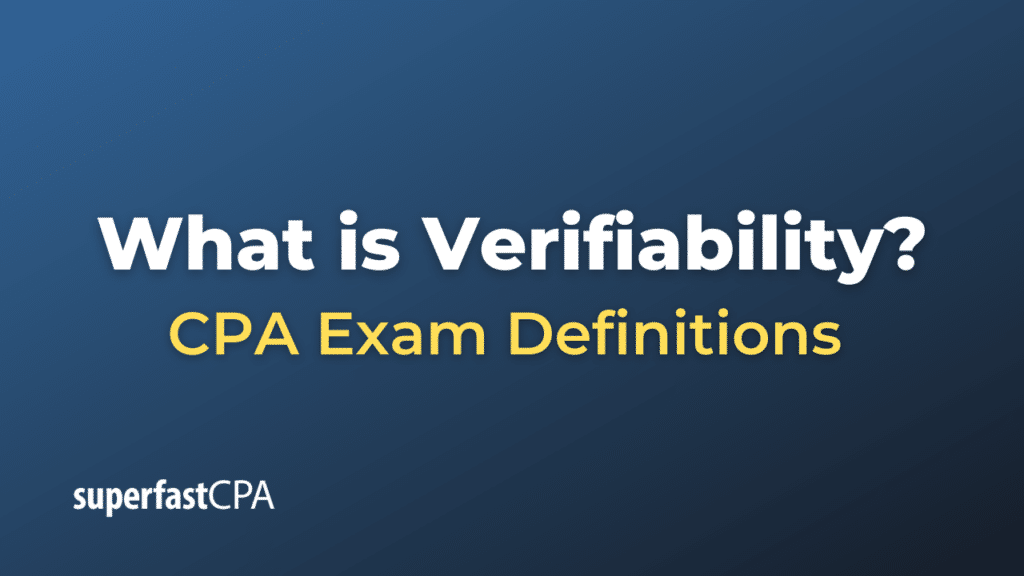Verifiability
In accounting, verifiability refers to the ability to ensure that financial information is reliably and accurately represented, such that independent observers could reach the same conclusions when given the same data or conditions. Essentially, verifiable information is supported by evidence that can be used to confirm its accuracy, reliability, and objectivity.
Verifiability is one of the fundamental principles in accounting, often considered alongside other key principles like relevance, comparability, and reliability. It’s particularly important because stakeholders such as investors, regulators, and auditors rely on the verifiability of financial statements to make decisions, assess compliance, and conduct audits.
Importance of Verifiability:
- Trust and Credibility: Verifiability builds trust among users of financial statements, such as investors, creditors, and regulators.
- Auditability : A crucial aspect of auditing involves verifying the financial information presented in the financial statements. Verifiability ensures that this process can be carried out effectively.
- Decision-making: Reliable and verifiable financial information enables stakeholders to make informed decisions about investments, credits, and other financial matters.
- Regulatory Compliance: Financial statements are often subject to regulations (like GAAP or IFRS). Verifiability ensures that the statements comply with these standards, making it easier to assess and compare financial health across different organizations.
Methods to Ensure Verifiability:
- Source Documents: Keeping all original source documents such as invoices, receipts, contracts, etc., so that transactions can be verified.
- Third-Party Confirmations: Obtaining confirmations from independent external parties who can vouch for the transactions or balances.
- Audit Trails: Maintaining detailed records that show how financial data was collected, processed, and summarized into financial statements.
- Internal Controls : Implementing rigorous internal control mechanisms to ensure that financial transactions are accurate, authorized, and recorded consistently.
- Transparency: Full disclosure of the accounting methods and assumptions used, so that anyone reviewing the financials knows how the numbers were derived.
Example of Verifiability
Here’s an example to illustrate the concept of verifiability in the context of accounting:
Background:
Imagine you are an auditor tasked with examining the financial statements of a company, “HealthyJuice Co.,” which claims to have made $1 million in sales during the fiscal year. The company states that their primary revenue source is from the sale of organic juices.
Objective:
Your main task as an auditor is to verify the accuracy of this sales figure.
Steps for Verification:
- Request Source Documents: Ask HealthyJuice Co. for all sales invoices, receipts, and bank statements related to the sales transactions.
- Match Transactions : Cross-reference each invoice with the respective bank statement to ensure that the payment was indeed received. Also, match the transactions recorded in the sales ledger with the invoices.
- Random Sampling : Choose a random sample of sales transactions and trace them back to the original source documents to confirm their accuracy.
- Third-Party Confirmation : Optionally, you may also seek confirmations directly from customers to verify the authenticity of the recorded sales transactions. This is usually done by sending letters to customers asking them to confirm the details of transactions they’ve had with the company.
- Check Tax Records: Examine tax returns and other regulatory filings to see if the reported sales figures match the records you have verified.
Outcome:
- Verified: If all documents match, and the sample checks out with no discrepancies, then you can confirm that the sales figure of $1 million is verifiable.
- Discrepancies : If you find issues such as missing invoices, unrecorded sales, or mismatches between bank statements and invoices, then the sales figure may not be fully verifiable, requiring further investigation or adjustment.
Importance:
- Credibility: Verifying the sales figure adds credibility to the financial statements of HealthyJuice Co., making it more reliable for stakeholders like investors, regulators, and creditors.
- Compliance: Verifiability ensures that the company is compliant with accounting standards and regulations, which is crucial for legal and ethical reasons.
- Decision-Making : Verified financial statements are essential for informed decision-making by stakeholders.
In this example, the auditor employs various methods to verify the accuracy of a critical financial figure—the annual sales of the company. This process underscores the importance of verifiability in providing accurate and trustworthy information.













